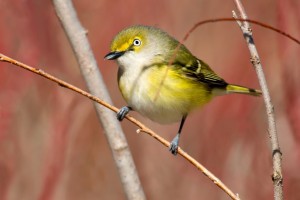A white-eyed vireo perches high on a tree branch scanning the understory below. She’s searching for the perfect place to raise her young. The nesting site must match the shopping list inside her head: lush, impenetrable thickets of young trees and gnarly shrubs. She needs young trees at least three feet high, filled with nooks to build one small nest out of bark bits, leaves, and small roots all glued together with a sticky spider web. Green chunks of moss on the outside plug any unsightly holes. But this vireo will have a difficult time finding what she’s looking for in the Connecticut forest.
She is in search of a rare habitat in Connecticut, the young forest and shrublands. According to CLEAR’s Changing Landscape Project about fifty-nine percent of Connecticut is covered by forest, but only six percent of the forest is considered young or in an early stage of development. If we imagine that a habitat is like a room, then the Connecticut forest, which is mostly mature, is like a house with only one room. It would be like our white-eyed vireo spending all of her time lying on the couch. Wildlife like birds, small mammals, and salamanders depend upon having multiple rooms — a variety of habitats at different stages of growth — to fulfill their needs: one room to find food, one room to raise a family, and another to feel safe.
What Can Be Done?
Create a disturbance in the forest. What does that mean? Cut down some trees. It’s really that simple.* Historically, natural disturbances such as wind, fire, Native American agriculture, flooding, and beavers created enough young forest, fields, and shrublands to protect species diversity. But, today, we put out the fires, prevent the floods and restrict beaver activity. Humans must now actively create and manage young forest and shrubland habitat for those species that depend upon disturbance.
Woodland Owners: We Need You
Eighty-three percent of CT forest is owned by private individuals and families. If you are a woodland owner, you have an opportunity to create young forests and shrublands for wildlife. The problem is that cutting trees typically meets with a lot of resistance, mostly because it will result in some parts looking, well, like a mess. But this mess serves a purpose. The forest will pop back up in a year or two, creating that much-needed dining room or bedroom. Then the birds will arrive. Then more birds the next year, and still more the year after that.
Curious? If you would like to know more about creating a mess for wildlife on your property, please contact the UConn Extension Forestry Team (uconnforestry@uconn.edu) and tell us your story. We would be thrilled to talk to you about our Young Forest Project!
To see what a young forest looks like in person, visit Sessions Woods Wildlife Management Area at 341 Milford St., Burlington, CT, where two young forest habitats were created in 2001 and 2013.
*Of course, always contact a certified forester before any cutting begins
Image Source: Shutterstock.com. White-eyed vireo.
